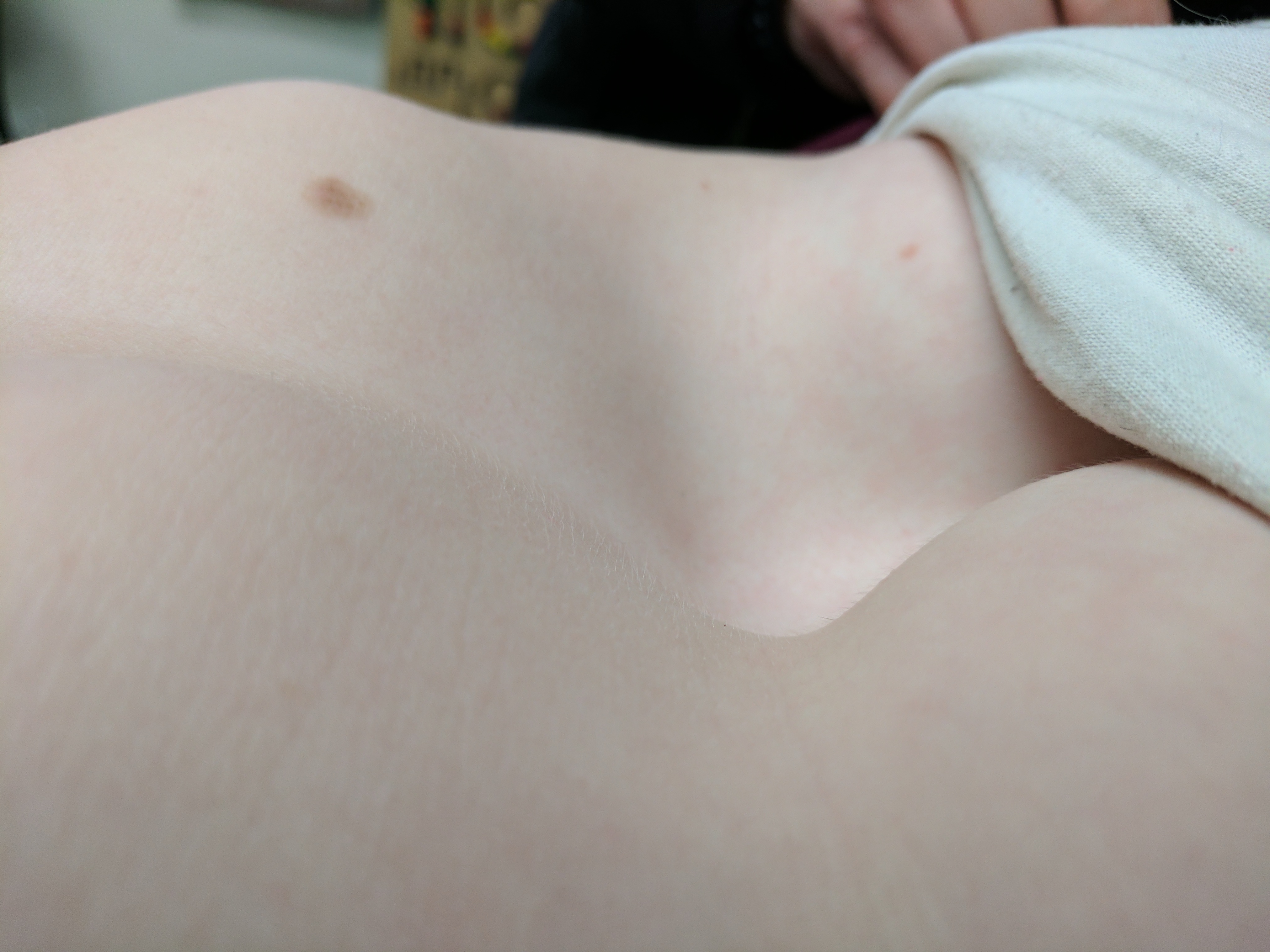[1]
Rha EY, Kim JH, Yoo G, Ahn S, Lee J, Jeong JY. Changes in thoracic cavity dimensions of pectus excavatum patients following Nuss procedure. Journal of thoracic disease. 2018 Jul:10(7):4255-4261. doi: 10.21037/jtd.2018.06.159. Epub
[PubMed PMID: 30174871]
[2]
Fortmann C, Petersen C. Surgery for Deformities of the Thoracic Wall: No More than Strengthening the Patient's Self-Esteem? European journal of pediatric surgery : official journal of Austrian Association of Pediatric Surgery ... [et al] = Zeitschrift fur Kinderchirurgie. 2018 Aug:28(4):355-360. doi: 10.1055/s-0038-1668131. Epub 2018 Aug 21
[PubMed PMID: 30130828]
[3]
Schwabegger AH. Deformities of the Thoracic Wall: Don't Forget the Plastic Surgeon. European journal of pediatric surgery : official journal of Austrian Association of Pediatric Surgery ... [et al] = Zeitschrift fur Kinderchirurgie. 2018 Aug:28(4):361-368. doi: 10.1055/s-0038-1668129. Epub 2018 Aug 15
[PubMed PMID: 30112747]
[4]
Brochhausen C, Turial S, Müller FK, Schmitt VH, Coerdt W, Wihlm JM, Schier F, Kirkpatrick CJ. Pectus excavatum: history, hypotheses and treatment options. Interactive cardiovascular and thoracic surgery. 2012 Jun:14(6):801-6. doi: 10.1093/icvts/ivs045. Epub 2012 Mar 5
[PubMed PMID: 22394989]
[5]
Abdullah F, Harris J. Pectus Excavatum: More Than a Matter of Aesthetics. Pediatric annals. 2016 Nov 1:45(11):e403-e406. doi: 10.3928/19382359-20161007-01. Epub
[PubMed PMID: 27841924]
[6]
Kelly RE Jr, Daniel A. Outcomes, quality of life, and long-term results after pectus repair from around the globe. Seminars in pediatric surgery. 2018 Jun:27(3):170-174. doi: 10.1053/j.sempedsurg.2018.05.003. Epub
[PubMed PMID: 30078488]
Level 2 (mid-level) evidence
[7]
Colombani PM. Preoperative assessment of chest wall deformities. Seminars in thoracic and cardiovascular surgery. 2009 Spring:21(1):58-63. doi: 10.1053/j.semtcvs.2009.04.003. Epub
[PubMed PMID: 19632564]
[8]
Sujka JA, St Peter SD. Quantification of pectus excavatum: Anatomic indices. Seminars in pediatric surgery. 2018 Jun:27(3):122-126. doi: 10.1053/j.sempedsurg.2018.05.006. Epub 2018 May 16
[PubMed PMID: 30078482]
[9]
De Feria AE, Bajaj NS, Polk DM, Desai AS, Blankstein R, Vaduganathan M. Pectus Excavatum and Right Ventricular Compression in a Young Athlete with Syncope. The American journal of medicine. 2018 Nov:131(11):e451-e453. doi: 10.1016/j.amjmed.2018.07.033. Epub 2018 Aug 1
[PubMed PMID: 30076820]
[10]
Lawson ML, Mellins RB, Paulson JF, Shamberger RC, Oldham K, Azizkhan RG, Hebra AV, Nuss D, Goretsky MJ, Sharp RJ, Holcomb GW 3rd, Shim WK, Megison SM, Moss RL, Fecteau AH, Colombani PM, Moskowitz AB, Hill J, Kelly RE Jr. Increasing severity of pectus excavatum is associated with reduced pulmonary function. The Journal of pediatrics. 2011 Aug:159(2):256-61.e2. doi: 10.1016/j.jpeds.2011.01.065. Epub 2011 Mar 22
[PubMed PMID: 21429515]
[11]
Kelly RE Jr, Obermeyer RJ, Nuss D. Diminished pulmonary function in pectus excavatum: from denying the problem to finding the mechanism. Annals of cardiothoracic surgery. 2016 Sep:5(5):466-475
[PubMed PMID: 27747180]
[12]
Emil S. Current Options for the Treatment of Pectus Carinatum: When to Brace and When to Operate? European journal of pediatric surgery : official journal of Austrian Association of Pediatric Surgery ... [et al] = Zeitschrift fur Kinderchirurgie. 2018 Aug:28(4):347-354. doi: 10.1055/s-0038-1667297. Epub 2018 Aug 15
[PubMed PMID: 30112746]
[13]
Velazco CS, Arsanjani R, Jaroszewski DE. Nuss procedure in the adult population for correction of pectus excavatum. Seminars in pediatric surgery. 2018 Jun:27(3):161-169. doi: 10.1053/j.sempedsurg.2018.05.002. Epub
[PubMed PMID: 30078487]
[14]
Goretsky MJ, McGuire MM. Complications associated with the minimally invasive repair of pectus excavatum. Seminars in pediatric surgery. 2018 Jun:27(3):151-155. doi: 10.1053/j.sempedsurg.2018.05.001. Epub
[PubMed PMID: 30078485]
[16]
REHBEIN F, WERNICKE HH. The operative treatment of the funnel chest. Archives of disease in childhood. 1957 Feb:32(161):5-8
[PubMed PMID: 13403703]
[17]
Nuss D, Kelly RE Jr. Minimally invasive surgical correction of chest wall deformities in children (Nuss procedure). Advances in pediatrics. 2008:55():395-410
[PubMed PMID: 19048741]
Level 3 (low-level) evidence
[18]
Wolf WM, Fischer MD, Saltzman DA, Leonard AS. Surgical correction of pectus excavatum and carinatum. Minnesota medicine. 1987 Aug:70(8):447-53
[PubMed PMID: 3657762]
[19]
Robicsek F. Repair of pectus excavatum. The Annals of thoracic surgery. 2010 Jul:90(1):363. doi: 10.1016/j.athoracsur.2010.01.024. Epub
[PubMed PMID: 20609833]
[20]
Weber PG, Hümmer HP. [The "new" Erlangen technique of funnel chest correction - minimalization of a well working procedure]. Zentralblatt fur Chirurgie. 2006 Dec:131(6):493-8
[PubMed PMID: 17206569]
[21]
Lacquet LK. [Surgical treatment of anterior chest wall deformities by sternochondroplasty and internal fixation without prosthesis]. Acta chirurgica Belgica. 1982 Nov-Dec:82(6):541-9
[PubMed PMID: 7158183]
[23]
Nasr A, Fecteau A, Wales PW. Comparison of the Nuss and the Ravitch procedure for pectus excavatum repair: a meta-analysis. Journal of pediatric surgery. 2010 May:45(5):880-6. doi: 10.1016/j.jpedsurg.2010.02.012. Epub
[PubMed PMID: 20438918]
Level 1 (high-level) evidence
[24]
Antonoff MB, Erickson AE, Hess DJ, Acton RD, Saltzman DA. When patients choose: comparison of Nuss, Ravitch, and Leonard procedures for primary repair of pectus excavatum. Journal of pediatric surgery. 2009 Jun:44(6):1113-8; discussion 118-9. doi: 10.1016/j.jpedsurg.2009.02.017. Epub
[PubMed PMID: 19524726]
[25]
Lam MW, Klassen AF, Montgomery CJ, LeBlanc JG, Skarsgard ED. Quality-of-life outcomes after surgical correction of pectus excavatum: a comparison of the Ravitch and Nuss procedures. Journal of pediatric surgery. 2008 May:43(5):819-25. doi: 10.1016/j.jpedsurg.2007.12.020. Epub
[PubMed PMID: 18485946]
Level 2 (mid-level) evidence
[26]
Kelly RE Jr, Mellins RB, Shamberger RC, Mitchell KK, Lawson ML, Oldham KT, Azizkhan RG, Hebra AV, Nuss D, Goretsky MJ, Sharp RJ, Holcomb GW 3rd, Shim WK, Megison SM, Moss RL, Fecteau AH, Colombani PM, Cooper D, Bagley T, Quinn A, Moskowitz AB, Paulson JF. Multicenter study of pectus excavatum, final report: complications, static/exercise pulmonary function, and anatomic outcomes. Journal of the American College of Surgeons. 2013 Dec:217(6):1080-9. doi: 10.1016/j.jamcollsurg.2013.06.019. Epub
[PubMed PMID: 24246622]
Level 2 (mid-level) evidence

